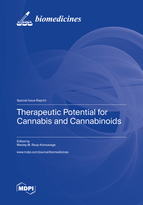Therapeutic Potential for Cannabis and Cannabinoids
A special issue of Biomedicines (ISSN 2227-9059). This special issue belongs to the section "Molecular and Translational Medicine".
Deadline for manuscript submissions: closed (30 November 2022) | Viewed by 67570
Special Issue Editor
Interests: cannabis; cancer; inflammatory bowel disease; pain; cannabinoids
Special Issues, Collections and Topics in MDPI journals
Special Issue Information
Dear Colleagues,
Cannabis has a history of medical use dating back millennia; however, the use of cannabis for medicinal purposes fell out of favor in the middle of the last century. There is currently a renewed interest in the potential medicinal value of this plant, as well as individual compounds produced by Cannabis (as well as synthetic analogs). Currently, nearly 50 countries permit the medical use of cannabis, and over a dozen other countries have legalized cannabis-based products (CBD, Sativex, Dronabinol, etc.) for medical use. While there exists a plethora of anecdotal reports that cannabis can treat a variety of diseases, there is a limited amount of strong, evidence-based scientific data to support these claims.
This Special Edition of Biomedicines, “Therapeutic Potential for Cannabis and Cannabinoids”, will be dedicated to providing evidence for the medicinal value of cannabis to treat human illness and disease. Topics will include but are not limited to preclinical animal models examining the efficacy of cannabis and cannabinoid derivatives on pain, anxiety, cancer, and other diseases; and cell and molecular models of cannabinoid pharmacokinetics, drug-drug interactions, and disease treatment. These studies will be of great importance not only for progressing the cannabis field, but also for validating the use of cannabis and cannabinoids as therapeutics.
Dr. Wesley M. Raup-Konsavage
Guest Editor
Manuscript Submission Information
Manuscripts should be submitted online at www.mdpi.com by registering and logging in to this website. Once you are registered, click here to go to the submission form. Manuscripts can be submitted until the deadline. All submissions that pass pre-check are peer-reviewed. Accepted papers will be published continuously in the journal (as soon as accepted) and will be listed together on the special issue website. Research articles, review articles as well as short communications are invited. For planned papers, a title and short abstract (about 100 words) can be sent to the Editorial Office for announcement on this website.
Submitted manuscripts should not have been published previously, nor be under consideration for publication elsewhere (except conference proceedings papers). All manuscripts are thoroughly refereed through a single-blind peer-review process. A guide for authors and other relevant information for submission of manuscripts is available on the Instructions for Authors page. Biomedicines is an international peer-reviewed open access monthly journal published by MDPI.
Please visit the Instructions for Authors page before submitting a manuscript. The Article Processing Charge (APC) for publication in this open access journal is 2600 CHF (Swiss Francs). Submitted papers should be well formatted and use good English. Authors may use MDPI's English editing service prior to publication or during author revisions.
Keywords
- cannabis
- tetrahydrocannabinol (THC)
- cannabidiol (CBD)
- cannabigerol (CBG)
- cannabinoid
- cannabinol (CBN)
- cannabichromene (CBC)
- pain
- cancer
- anxiety
- PTSD
- sleep disorders
- neuroprotection
- anti-inflammatory
Related Special Issue
- Therapeutic Potential for Cannabis and Cannabinoids 2.0 in Biomedicines (10 articles)







